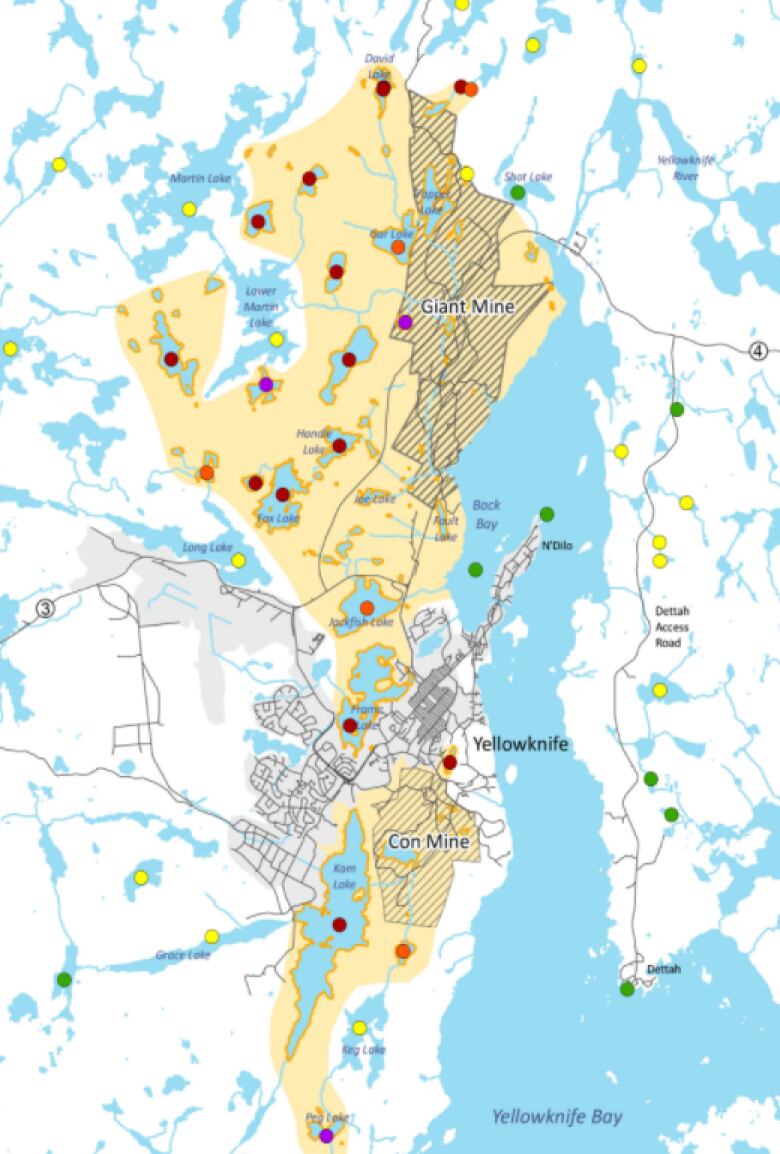Follow the dots: N.W.T. issues health advisory, new map showing arsenic levels in Yellowknife lakes
Rat Lake and Meg Lake, near Con Mine site, both identified with elevated arsenic levels

The N.W.T.'s chief public health officer has sent out a renewed health advisory about arsenic in lakes in the territory, particularly those near Giant and Con Mines.
Dr. Andre Corriveau is advising residents about "precautions they can take to avoid exposure to elevated arsenic levels found in some small lakes around sites of past industrial activity," a news release said Tuesday.
The N.W.T. Department of Health and Social Services also released a new map showing arsenic levels in lakes and bodies of water around Yellowknife.
Corriveau told CBC that the Department of Environment and Natural Resources did a lot of testing on lakes this spring and the health department received results in the last few weeks.
"We have more up-to-date data on each of the lakes, and there's a few smaller lakes that actually we didn't have data before that have been added in."
There are notable differences between the latest map and a map the department released in April 2017.
-
Health officials downplay high arsenic concentrations in Yellowknife-area lakes
-
Frequent swims in Kam Lake probably not good for pets, says veterinary toxicologist

Rat Lake and Meg Lake, both near Yellowknife's Con Mine site, have now been identified with elevated arsenic levels. Rat Lake is noted with a red dot, at 100-499.9 parts per billion; Meg Lake is orange with 52-99.9 parts per billion.
Health Canada's guidelines says less than 10 parts per billion is an acceptable standard for drinking water.
The public health advisory states that water should not be consumed in lakes noted with red, orange or purple dots.
"It is also recommended to avoid fishing, swimming, and harvesting berries, mushrooms and other edible plants within the immediate vicinity of these lakes," the public health advisory says.
It says walking through those areas does not pose a health risk.
Grace Lake gets worse, Kam Lake improves
The rating for Grace Lake, a popular swimming spot with many homes along the shore, has gotten worse going from a green rating of 0-9.9, to a yellow rating of 10-51.9 parts per billion of dissolved arsenic.
"Lakes with yellow points: Arsenic levels are above Health Canada's drinking water guidelines; however, occasional exposure does not pose a significant risk for arsenic-related health effects," the advisory says.
"These lakes are considered safe for swimming and fishing."
Kam Lake's rating has improved slightly, going from a purple rating the worst rating, above 500 parts per billion to red.
-
Decades-old study shows Kam Lake's arsenic levels 50 times over drinking water standard
-
N.W.T. health dept. didn't know Kam Lake is being regularly tested for arsenic
Peg Lake, south of Kam Lake, was added to the new map and has a purple rating.

One unnamed lake near the Giant Mine site got worse, going from an orange to red rating in the updated map. A purple rating was added to another body of water near Giant Mine.
"Those are the most heavily contaminated lakes with regard to arsenic," Corriveau said.
"We recommend that they not be used for recreational purposes, for swimming. And that if you're going to be fishing there, you shouldn't be eating the fish. You should just catch and release.
"Jackfish Lake, Frame Lake and Kam Lake would be examples of that."
Ndilo, Back Bay andDettah'completely safe'
Waters around Ndilo, Back Bay and Dettah, which were not previously rated on April's map, are now noted with green dots, which is the lowest arsenic rating.
Corriveau said Yellowknife's Back Bay, home to the city's houseboat community, is tested regularly.
"The little data we have on fish has been good so far. I've never seen any high levels in the fish," he said.
"I know more work is being done, but at this point we consider those areas completely safe."
Corriveau said Prosperous and Prelude Lakes on the Ingraham Trail are also rated green.
"Those lakes are safe for recreational use," he said.
Green ratings have arsenic levels below Health Canada's drinking guidelines, however the health department says people should not drink untreated water from any lake.
The Yellowknife and Cameron Rivers are not rated on the map, but the advisory says they "have been regularly tested for arsenic for many years and have always been shown to be well below drinking water guidelines."
"The Yellowknife River is tested regularly because it's a source of our drinking water," Corriveau said.
"Actually there's tests that are done I think almost monthly by the city on these rivers. They're a perfectly good source, that's why we authorize it as a source of drinking water."












_(720p).jpg)


 OFFICIAL HD MUSIC VIDEO.jpg)
.jpg)



























































































